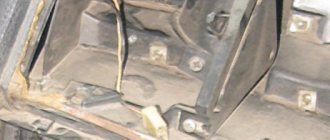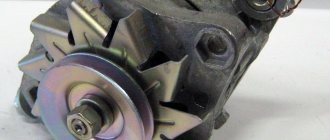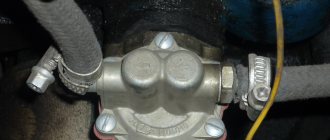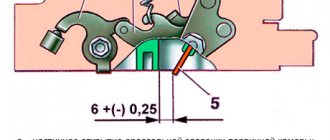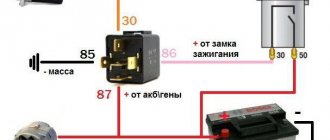Such a detail as the VAZ 2114 window regulator is the key to not only a comfortable, but also a safe trip in any weather. If it breaks down in rain or snow, the driver must stop driving on the road and carry out repair work or call a tow truck. Today we will talk about why window regulators break and how to completely replace them if necessary.
Window regulator VAZ 2114
The window lifter on the VAZ 2114 does not work
As standard, on a VAZ-2114 car, only two window lifters are installed on the right and left sides of the front doors. If a malfunction is identified due to the failure of both power windows, you will first have to check the thirty-amp fuse F6, located in the mounting block under the hood of the car.
If it is burnt out, then it needs to be replaced with a new one. Well, the driver will have to look for the reason for the failure of this fuse, because if this is not done, then the new fuse will burn out in the same way. When searching for a short circuit, it is necessary to take into account at what point the fuse blows. If this happens when the power window is turned on, then most likely there is a short circuit under the door trim, and if the fuse burns out immediately after the ignition is turned on, then most likely the wiring is shorted to ground, somewhere from the mounting block to the door trim.
The weak point that leads to chafing of the insulation of the wires going to the electric window lifter motor is the transition of the bundle of wires from the passenger compartment under the door trim. Therefore, this place needs to be checked first.
If the fuse is intact, then you will have to remove the door trim and check the voltage at the contacts in the plug connectors of the wires suitable for the window lift motor. This can be done very simply using a test light (one wire to the contact, the second to ground, if the light is on, it means there is voltage). If there is voltage and the window lift motor is not working, it will have to be replaced.
In addition to the fuse, the cause of the window regulator not working can be the failure of the K5 relay located in the mounting block. A relay that is not working is usually replaced with a new one. Sometimes, the window lift motor stops working as a result of warping of the thermobimetallic fuse built into the motor to protect it from overloads.
Also, the cause of a non-functioning window lifter can be mechanical faults. These include: failure of the worm gear, which serves to reduce the rotational speed of the electric motor shaft, and problems associated with the cable drive. During operation, the window lift cable stretches and increases in length, which leads to incomplete lowering of the side window. In addition, the extended cable can jump off the guide rollers and then there is nothing to move the side window.
Tracks or contacts in the mounting block
Another reason may be a broken contact of the mechanism relay in the mounting block.
Considering the circuit of the mounting block, we can conclude that a constant plus comes to pin 30 through a fuse, and when we turn on the ignition, we apply another plus to pin 85. As a result of turning on the ignition, an electromagnetic field appears, which closes pins 30 and 87, which provides power to window lift buttons.
This means that if the operation of the plus on the ignition switch is disrupted, the contacts stop closing, even if the relay is in working condition. You can check this by closing contacts 30 and 87 directly, then the plus will come without the ignition switch and if the problem is in it, then the power windows will work.
The video demonstrates another solution to this problem:
But there may also be the opposite situation, that we do not have a constant positive supply to pin 30, and when we turn the ignition key, the contacts close, but nothing happens. In this case, it is best to ring the contact with a tester and find out whether there is constant voltage. For testing, you can connect the plus directly to pin 87, but this is not safe, since the wire will go outside the fuse.
Causes of malfunction
So, we gradually approached the issue of malfunctions. What if the window regulator cannot go down or up? Before you remove the window regulator, disassemble and repair it in your car, let's look at the main reasons. If the rear or front windows do not work, the reason may be either electrical or mechanical.
Detailed design of the EP system
Electrical faults
First of all, if the window regulator has stopped working, it is necessary to diagnose the safety element responsible for the functionality of the system. If you realize that the power window is not working due to a fuse, then you just need to replace it. But if the fuse is working, then you will need to measure the voltage at the electric motor terminals. This task can be accomplished using a regular 12-volt lamp or using a tester.
We recommend: The design of a manual transmission and how it works
If you find that the driver's window or any other door does not work due to voltage, then you need to further check:
- wiring;
- relay;
- system control unit.
Sometimes a car owner thinks that the window regulator is broken if, after opening the window, it automatically begins to close until the key is turned in the ignition. As a rule, in this case the problem lies in the contacts, which should be cleaned. Much less often, but it still happens that repair of electric windows includes replacing or repairing a button.
Mechanical defects of the mechanism
If, after measuring the voltage, you realize that there is current in the system, but it does not go down or the window regulator does not work at all, most likely the problem is mechanical. As a rule, in this case, something is interfering with the device, so you will have to disassemble the door and look for the reason. Much less often, the reason lies in a failed electric motor (the author of the video is the channel In Sandro’s Garage).
How to raise the glass if the electric seal is broken - there are several options:
- Purchase a window regulator repair kit and repair the device, after which you can fully use the system.
- Try to grab the glass on both sides with your hands and pull it up. If the glass falls after being lifted, you will have to disassemble the door and place a support of the appropriate size under it.
- If you can’t lift the glass with your hands, you can take a fishing hook on a fishing line and lower it into the door card. You need to try to pry the glass and lift it.
Dismantling the old unit
If the electrical elements have been more or less decided, then the mechanical part of the problem is much more complicated. The described VAZ models have non-separable ESP structures. They are characterized as the most reliable, but in case of breakdown they require a complete replacement from the owner.
How the structure is dismantled.
- Remove the handle and rod.
- Lowering the glass, remove the holder.
- The glass is raised to the maximum and secured with tape.
- Unscrew all the nuts holding the mechanism to the door.
- Dismantling is complete and the device can be completely removed for diagnostics.
Next, you will decide whether to repair or replace with a new device.
Such a detail as the VAZ 2114 window regulator is the key to not only a comfortable, but also a safe trip in any weather. If it breaks down in rain or snow, the driver must stop driving on the road and carry out repair work or call a tow truck. Today we will talk about why window regulators break and how to completely replace them if necessary.
Window regulator VAZ 2114
Installation Features
The connection diagram is the opposite of the above method of removing the device and, in general, has no special nuances. If you have completed the removal operation, then installing the VAZ 2114 electric windows will not be a problem.
The only nuance that you should not forget about is the window lifter guides. Before completing the connection, it is better to lubricate them - then the mechanism will last longer.
The problem with the passenger window not working has been resolved.
Good day to all.
Almost immediately after I switched to 2114, I encountered the problem of the window regulator on the passenger side not working at times.
It looked something like this:
Due to the fact that this happened mainly after washing.
I began to sin because the door was somehow miraculously flooding. I start the car, the window lifter doesn’t work, I drive it, I press it... it’s just miracles. A Google/drive search revealed several possible reasons: 1. A broken wire or a short to ground at the point where the wires pass from the passenger compartment to the door, 2. Failure of the window lift motor/wear of the gear on the mechanism. 3. Malfunction of the button The blown fuse was dismissed immediately - everything was fine on the driver’s side. Yesterday I had a free evening and started disassembling the casing. I examined all the possible wires in the door and was ready to look further, in the corrugation, but... There are two wires in the door connected through a white connector (the wires themselves are white and blue, the photo shows what they look like.
The white and blue wires are connected with a white connector
It was discovered that one of the wires on one side had come out of the chip, so, apparently, while jumping on bumps, the contact appeared and disappeared.
Therefore, if you encounter a problem of this kind, first check all connections, this way you can get by with little damage)
The 2113 had a tuned radiator grille. It so happened that before selling it, I installed the factory one I had bought at a disassembly, but this one remained gathering dust + was not in excellent condition, with broken fasteners.
I began to make a blank lattice out of it (and possibly with holes, and possibly with a mesh).
Stretched vertically. to give it a more even shape. I covered it with fabric and doused it with epoxy. Let's see what happens.
Peace for everyone.
Lattice. Due to the fact that it lacked rigidity, the top was crooked
Where is the door window lift located?
On cars of the Samara 2 family, different types of window lifters are installed, namely, there are electric ones in the front, and mechanical ones in the back (If the car is in a top configuration, then there are electric ones in the back), both types are hidden in the door itself and you won’t see them without removing the trim, so for For clarity, in the photo below, the trim was removed from the front door of the car, and the window regulator itself is indicated by a red arrow in this photo.
The power window does not work, we are eliminating the problem.
The weak point that leads to chafing of the insulation of the wires going to the electric window motor is the transition of the bundle of wires from the passenger compartment under the door trim. Therefore, this place needs to be checked first. If the fuse is intact, then you will have to remove the door trim and check the voltage at the contacts in the plug connectors of the wires suitable for the window lift motor. This can be done very simply using a test light (one wire to the contact, the second to ground, if the light is on, it means there is voltage). If there is voltage and the power window motor is not working, it will have to be replaced. In addition to the fuse, the cause of the window regulator not working can be the failure of the K5 relay located in the mounting block. A relay that is not working is usually replaced with a new one. Sometimes, the power window motor stops working as a result of warping of the thermobimetallic fuse built into the motor to protect it from overloads.
Also, the cause of a non-functioning window regulator can be mechanical faults. These include: failure of the worm gear, which serves to reduce the rotational speed of the electric motor shaft, and problems associated with the cable drive. During operation, the window lift cable stretches and increases in length, which leads to incomplete lowering of the side window. In addition, the extended cable can jump off the guide rollers and then there is nothing to move the side window. We recommend starting your search for a problem by classifying it, thereby narrowing the list of causes to two groups: First of all, check the power window fuse (on a VAZ 2110 this is fuse F5).
If it is intact, then we check the voltage at the terminals of the window motor using a multimeter or a regular 12V light bulb. If there is no voltage, then we carefully check the wiring, the power window relay, and then the control unit (if any). See also: If the window regulator malfunctions, for example, when you press the button, the window opens, but does not lock and immediately closes itself. Or the button stops working until you turn the ignition off/on. The cause of the problem is the button. It should be removed, the contacts cleaned, and replaced if necessary. If voltage is supplied to the window lift motor, but the window does not move, it means that something is interfering with it, or the power window motor is faulty. Why doesn't the window lift motor work? One of the reasons is retraction or sticking of the drive motor brushes. To check this, turn on the ignition and press the power window button while simultaneously knocking on the car door several times.
The brushes will come off and the ESP will start working. How to repair the window regulator in this case? You should remove the motor casing and pull out the rotor. Clean off deposits where the brushes touch with fine sandpaper. The power window does not work, you can hear a growling sound, but the glass does not stand still, or the window regulator is stuck. Perhaps the plastic gear in the gearbox has worn out, as a result it sticks tightly in the extreme closed position, or slips and therefore cracks. Is there a loud noise when the window goes up/down? Most likely the bearing in the window regulator motor is to blame. The power windows have stopped working, but there is noise when you press the button, and replacing the motor did not help? The power window cable may have frayed due to overtightening.
The window has opened, but the window regulator does not raise it back, but can it be raised and lowered by hand? The window lift cable broke or simply flew off the guides. Another malfunction of the window regulator, when the glass seems to jerk, trying to close. Most likely the problem is that the glass is skewed, or something got on the rail or roller. The power windows don't work well. Try to lubricate the window lift mechanism, as well as the glass guides. If this helps only temporarily, then try adjusting the glass and the window regulator itself. If the window regulators operate slowly, try lubricating the window regulator mechanism and the window guides. Perhaps this is their maximum operating speed, so the only correct solution would be to replace them with new ones (see). By the way, do you know how? Photo source: from Drive2 website. ru from the Drive2 website. ru
VAZ 2114. Why don't the power windows work?
The fuse and relay are ok, what should I do?
The fact is that after checking the relay and fuse, you forgot that external lighting is also involved in the power supply of the ESP. Personally, I had such a problem, I checked the fuse, relay, removed the door trim and checked the entire circuit. At the service station, the repair took 5 minutes, it turned out that the fog lights, which I don’t have, were burnt out.
1-mount fuse block.
2-button power window of the right front door.
3-motor (motor-reducer) for the window lifter of the right front door.
4-motor (geared motor) glass lift of the left front door.
5-button power window of the left front door.
To 5 window relays,
A - to the power source,
In-to the external lighting switch
Of course, the window regulators may not work if something just fell off. Yes, while driving, it also happens that a bolt comes out somewhere. After all, our roads do not really meet the standards. And even more so, if you have electric windows, then the contact may simply fall off. So the reason will have to be found out. And you just need to start by checking whether voltage is supplied to the motor, which raises the windows.
Well, then you’ll have to disassemble the lifting mechanism and see how it works and whether anything got in there.
And only after this is it necessary to check the motor itself. Since it can simply fail.
If the window regulators do not work, both at once, then the motors simply could not burn out and only the fuses of all other circuits and, first of all, the lighting are to blame. Check them and the problem will probably be fixed.
VAZ 2114 can be equipped with either conventional manual (mechanical) window lifters or electric windows.
If we are talking about electric windows, then as a rule (at least quite often) the cause of the breakdown is in the electric motor![] which is responsible for raising and lowering the windows, that is, it simply burned out.
The window lift motor on the VAZ 2114 is not dismountable, only replacement.
Perhaps the problem is in the fuse (the most simple failure) the fuse box, like in its predecessors (VAZ 2109, VAZ 2108), is located under the hood.
True, sometimes just replacing the fuse is not enough; sometimes you need to look for the reason why it (the fuse) blows.
Perhaps the wires are shorted to ground, you need to remove the door trim and see what’s wrong, perhaps the insulation of the wires is broken.
Maybe the reason is in the relay, it is located in the same block under the hood, relay K5, here too only a complete replacement is required.
Or there may be a breakdown in pure mechanics, for example, a worm gearbox has failed, or a problem with the cable drive.
The window lifter system on the domestically produced VAZ 2114 car is quite simple and consists of the following mechanisms:
- motor or mechanical crank
- lifting mechanism with a set of gears
- adjustable lifting device
There are several reasons why power windows may not work:
- No current reaches the electric motor connector. The cause could be a blown fuse or a break in the electrical wiring.
- The problem is in the motor, this is either a loss of current through the electrical wiring or a failure of the motor itself. The motor is removed and current is supplied to it with reversal of polarity; the motor should rotate freely in different directions.
- Failure (mainly the teeth are worn out, resulting in the mechanism jamming) of the lifting mechanism. It is not repairable, only replacement.
- The bushings on the adjustable device come off due to wear.
- The glass has jumped off and rested against something, which is why the mechanism simply cannot raise it (or lower it)
- A foreign object has entered the mechanism.
https://autoflit.ru/291-ne-rabotaet-steklopodemnik-na-vaz-2114-remontiruem-bez-storonney-pomoschi.htmlhttps://remontvazov.com/steklopodemnik-vaz-2114https://ladaprofi.ru/ vaz-2114/chto-delat-esli-ne-rabotaet-steklopodemnik-vaz-2114.htmlhttps://helping-auto.ru/vaz/2114/ne-rabotaet-steklopodemnik-na-vaz-2114/https:// www.remotvet.ru/questions/15182-vaz-2114-pochemu-ne-rabotajut-steklopodemniki.html
When should you replace your door window regulator?
If we are talking about an electric window lifter, then as a rule, when it fails, the glass stops going up and down when you press the corresponding button, in addition, on some cars (you most likely have already paid attention to this) it happens that the glass somehow goes down (Slowly ) and almost does not rise (you have to help with your hand), this also indicates that the window lifter has become unusable and requires replacement, but by the way, in some cases, due to the fact that the glass does not rise and fall poorly, it may not even be the window lifter itself that is to blame glass, it’s just that over time its fastening weakens and thus the glass becomes skewed, which is why problems occur with lowering and raising the glass on the car, but as for mechanical window lifters, everything is simple here, if by rotating the handle the glass has ceased to be adjusted, then the window regulator itself has failed and requires replacement.
The most common reasons why the VAZ-2114 window regulator does not work
There is no point in arguing that power windows significantly increase the operating comfort of a car. But most drivers also know that they cause a lot of trouble. By the way, when it comes to the breakdown of the mechanism, we must not forget that the problem may not be in it, but in the glass itself. Over time, the holder or seals wear out, which often leads to a banal misalignment, which significantly impedes the freedom of movement of the glass.
The design of the window lifting mechanism is quite simple, but not reliable. And the fact that the safety block is placed in a place where moisture and dirt can easily get in is also not a plus. As you know, the slightest wear of the insulation can lead to a short circuit and breakdown of the entire system.
The most common reasons why a window regulator fails are the following:
- Damage to the components of the control unit.
- The contacts have oxidized and the circuit has opened.
- Disconnecting the power supply.
- The control button has stopped performing its functions.
The windows of the VAZ 2114 do not work
It often happens that the window regulator of the VAZ 2114 does not work, and this causes a lot of problems.
Such a thing as electric windows on this model significantly increases comfort compared to previous AvtoVAZ models, and there is no desire to lose them at all. The design of the window lifters itself is simple, but at the same time, not the most reliable. In addition, the fuse box is located under the hood, right under the water drainage area. Because of this, water can get into it and a short circuit or oxidation of the contacts may occur. The VAZ 2114 window regulator does not work for several main reasons, including: failure of control elements, oxidation of contacts and power loss. On this page we will talk in detail about each of the possible problems, and what ways there are to check and eliminate them. Probably the most common reason for a power window not working is a non-working button. Let's start with it. Many car owners of VAZ cars have noticed that over time, window regulators work more and more slowly. Often this happens precisely because of problems with the ESP buttons. Inside the buttons, the contact between the plates becomes worse and worse, to the point that it disappears completely and the glass stops rising and falling.
The main reason for a non-working button is the failure of one of the window regulators to work. It is almost impossible for two buttons to stop working at once. And since all the ESP buttons on this car are the same, instead of a button whose window lifter does not work, you can install a button from a working mechanism.
You can swap the buttons on the driver's door. To do this, you need to use a flat screwdriver or a knife to pry the buttons themselves and remove them from the chips. Then we connect the buttons by swapping their places. If a non-working window regulator has started working, and previously the working one has stopped functioning, then the non-working button must be replaced or repaired.
After removing the button, we move on to the workplace. On the sides of the case there are latches that need to be bent, after which the upper part can be removed without any problems. Next, remove the “rocker” that needs to be pressed, and the two metal plates. We see the board, it needs to be unsoldered, but before that, mark the location with a marker.
The soldered board should be set aside. Now you need to bend the upper contacts, which are pressed by the rocker to the lower contact, so that there is enough clearance between them for cleaning. We clean the contacts well with fine-grained sandpaper and reassemble the button in the reverse order. Let's go put it in the car and test it. If everything is done correctly, the button will “come to life” and will function no worse than a new one.
The power window relay can also fail, causing the power windows to not work. Having opened the cover of the fuse box, you need to find the relay and fuse responsible for the ESP according to the diagram on the cover. First we look at the fuse, if it is intact, then move on to the relay. There should be no plaque on the legs of the relay and fuse, and if there is any, then you need to remove it with WD-40, but it would be better to remove the entire mounting block for cleaning. Plaque indicates moisture ingress, causing the loss of current conductivity between the contacts. With a high probability, after removing the plaque the mechanism will work, however, there is no guarantee that after the next rain or wash the problems will not start again.
The ESP relay can be checked by simply replacing it with another relay that is known to be working, for example, from the high beam. If after rearranging the windows work, then the non-working relay goes to the trash. All that remains is to buy and install a new one.
If the fuse is blown, then replace it with a intact one and check the operation of the ESP. In a situation where everything works, the problem can be considered solved. It happens on a VAZ that fuses blow out for no good reason.
But, if only the installed fuse has blown, then there is a short circuit in the power circuit. Perhaps the power wire is broken somewhere and has a short to ground. It is better to entrust the solution to such a problem to auto electricians.
Another problem may arise with the window lift motor. The worm mechanism inside it may break. With this problem, the motor will be heard inside the door, but the glass will not move. The motor may also simply burn out.
The mechanism itself for raising/lowering the glass breaks extremely rarely, but because of it, the window regulator of the VAZ 2114 also does not work. The symptoms of a broken mechanism are as follows: the glass twitches a little, but does not move as it should, and the tense buzzing of the motor can be heard.
How to connect a button?
The driver and passenger door buttons are connected to each other, as well as to the ESP motor and power cable. Correct pinout of the power window button:
- Pin 1 on the driver's door is connected to pin 6 on the passenger side. Contact 1 on the passenger door is connected to the negative terminal of the ESP motor.
- Pin 2 on both buttons is connected to power.
- Pin 3 is the ground on the driver's side and the positive wire on the passenger's side.
- Contact 4 in both cases goes to the headlight switch.
- Contact 5 is ground in all cases.
- The positive wire of the ESP motor corresponds to pin 7 of the passenger door button.
Electrical problems
It is better to start diagnosing a malfunction by checking the condition of the fuse, which is responsible for the operation of the power windows in the VAZ 2110. Usually it is numbered F5. If necessary, the fuse must be replaced with a new one. If it is intact, proceed to the next stage. You will need a 12 volt light bulb with two wires going to its positive and negative side.
Connect the wires to the terminals of the window lift motor and press the button. If the light comes on, the wiring is good, but if not, start looking at the wires for breaks. Also don't forget to check the corresponding relay.
Another problem with the electrical wiring circuit is when the window opens when the button is pressed, but when it is released the glass rises again. In some cases, the button does not work until you turn the ignition off and on. These signs indicate a malfunction of the button, so you can try to remove it and clean the contacts, and if necessary, replace it with a new one.
VAZ 2114 (2113) stops do not work
The VAZ 2114 (2113) car is equipped with brake lights in the rear lights (one in each light). Plus, an additional brake light in the spoiler on the rear door. There are few reasons why the brake lights of a VAZ 2114, 2113 car do not work. Let's list them all and try to figure out this problem ourselves.
The brake light bulb in the rear light is burnt out.
Most often, only one lamp burns out, but sometimes two lamps burn out.
Brake light (stop) lamp in the rear light of a VAZ 2114 (2113) car
In this case, you will have to replace the lamp with a new one or a known good one. The brake light uses a P21W lamp. Similar lamps for the turn signal, reverse light, and fog light are in the same rear light. They can be used to check the brake light by replacing it.
The contacts in the stop lamp socket have oxidized
In this case, a “break” occurs in the electrical circuit of the lamp. Most often, in this case, one brake light will not work, while the other will be on.
Cartridge and contacts of the brake light lamp in the rear light of VAZ 2114, 2113
To restore contact, you need to turn the light bulb in the socket several times, or remove it and clean the oxidized contacts with fine-grained sandpaper.
The wiring block for the rear light is faulty (chip)
Either it is not securely fastened, or the contacts have oxidized. In any case, there will be an open circuit in the electrical circuit.
It is necessary to remove and put the block on the terminals of the rear light board several times to restore oxidized or unreliable contact. Subsequently, you can clean the pins on the board and the wire tips in the connecting block.
The fuse in the mounting block has blown
If the fuse is blown, both brake lamps in the taillights will not light.
The electrical circuit for turning on the brake lights of the VAZ 2114 (2113) is protected by fuse F3 (7.5A) in the fuse and relay mounting block. Check the integrity of the fuse. If faulty, replace with a new one. If the fuse is blown again, you should look for a short circuit in the circuit. According to the connection diagram shown below.
The track in the rear light board has crumbled
As a result, the electrical circuit will be broken (“open”), and the brake light lamp will not light up.
Tail light board tracks for brake light
It is necessary to remove the rear light board where the brake light is not illuminated and inspect it for damage to the tracks. If you cannot visually detect the location of the damage, you should “ring” the tracks with a multimeter or test lamp. Wiring is soldered to the damaged track and the board continues to function. For details, see the article “Checking the rear light board.”
The rear light ground is missing
In this case, one or two lights may not work. The negative wire of the lamp of each of the rear lights comes out of its connecting block of wires (chips) and is attached to the body next to it. Over time, this connection oxidizes and the contact disappears (the circuit opens).
It is necessary to unscrew the nut securing the tip of the negative wire to the body. Clean the pin and tip. After which the contact will be restored and the stop will light up.
Brake light switch faulty
If it malfunctions, both brake lights will not light up. The switch is located under the brake pedal and, after pressing it, closes the contacts of the electric stop circuit.
We remove two wires from it - white-red and pink-red, and connect them together with a piece of wire. The brake lights are on fire - we change the sensor, no, then we check the electrical circuit. In addition, we check the adjustment of the free play of the brake pedal, since the position of the switch may be broken, it does not work completely and the contacts do not close.
“Open” in the electrical circuit of the stop lamps
The cause of the “break” may be insecurely fastened wire harness chips, oxidation of the contacts in them, breaking of the circuit wires or their damage as a result of repairs.
Using a multimeter in voltmeter mode, you can check the presence of voltage in various parts of the electrical circuit and determine the damaged area. The best way to do this is to use a diagram.
Stop lights (brake lights) in the rear lights of a VAZ 2114, 2113 car, wiring diagram
First of all, we check the presence of voltage at the tip of the red wire in the rear light blocks to understand the malfunction in the lights or circuit. Then we check for voltage at the tip of the white-red wire of the brake light switch under the brake pedal.
Diagram of the VAZ engine management system with BOSCH controller - ECM 21104 1.6 16V
1 – block of the ignition coil wiring harness to the ignition system harness; 2 – block of the ignition system harness to the ignition coil wiring harness; 3 – ignition coils; 4 – immobilizer warning sensor; 5 – immobilizer control unit; 6 – spark plugs; 7 – nozzles; 8 – diagnostic block; 9 – block of the ignition system harness to the ABS cabin group harness; 10 – controller; 11 – electric fuel pump; 12 – block of the ignition system harness to the fuel level sensor harness; 13 – fuel level sensor harness connector to the ignition system harness; 14 – block of the ignition system harness to the injector harness; 15 – injector harness block to the ignition system harness; 16 – block of the ignition system harness to the side door harness; 17 – speed sensor; 18 – idle speed regulator; 19 – throttle position sensor; 20 – coolant temperature sensor; 21 – mass air flow sensor; 22 – oil pressure warning lamp sensor; 23 – phase sensor; 24 – oxygen sensor; 25 – crankshaft position sensor; 26 — knock sensor; 27 – solenoid valve for purge of the adsorber; 28 – oil level sensor; 29 – coolant temperature indicator sensor; 30 – block of the ignition system harness to the instrument panel harness; 31 – instrument panel harness connector to the ignition system harness; 32 – ignition relay; 33 – ignition relay fuse; 34 – fuse for the electric fuel pump power supply circuit; 35 – electric fuel pump relay; 36 – electric fan relay; 37 – controller power supply fuse; 38 – ignition system harness block to the air conditioner connector; 39 – instrument cluster; 40 – ignition switch; 41 – electric fan of the cooling system; 42 – on-board control system unit; 43 – starter relay; 44 – contacts of the 8-terminal blocks of the instrument panel harness and the front harness; 45 – contacts of the 21-terminal blocks of the instrument panel harness and the rear harness; 46 – trip computer; 47 – diagnostic connector.
Design and types of window lifters
The window regulator of the VAZ 2115, VAZ 2114 and other models of cars in this series can be of two main types. The mechanisms on the VAZ 2115 or 2114 do not have any fundamental differences from other models of the family.
The first of them is collapsible. They consist of two parts, a motor and a trapezoid, which are connected with fine thread bolts. If necessary, you can replace one of these parts while leaving the other. Previously, this was the most profitable option, since repairing a window regulator was much cheaper. Most often the trapeze had to be removed and replaced.
But in recent years it has been quite difficult to find high-quality trapeze on sale. Almost everything that is in stores lasts a month or two, and then again requires replacement. Therefore, collapsible device models are no longer so popular.
The second option is non-separable models. They are solid and do not allow the replacement of individual parts. On the other hand, a new non-removable factory window regulator for the VAZ 2113 and other models can last up to 3-5 years without requiring replacement. And with adequate use, even longer.
In addition to these types, devices are also distinguished by their operating principle. These are mechanical and electric windows of the VAZ 2114 and other models. The latter are also divided into lever, cable and rack and pinion. Their main difference is how the impulse of movement from the engine is transmitted to the plate holding the glass. This can be done by cable, lever or using a rack system.
Removal instructions
Disassembled door
If you don’t know how to remove the window handle, don’t despair, it’s easy to do. Before removing the mechanism, you need to remove the trim from the door. Then be sure to disconnect the wire block and the power window connector. Then remove the three nuts that secure the mechanism to the door. Next are two bolts that secure the lift and the glass itself.
Dismantling process
Then, lift the glass to the very top and fix it, you can use a screwdriver or ask someone to hold it. But it’s better to pull it out, because otherwise there is a risk that the glass may break.
To completely remove the mechanism, you need to additionally remove the door handle. To do this, unscrew its two screws and push the handle inside the door. Then, you will need to disconnect the rubber holder that holds the rod on the handle. Once you're done with this, you can pull out the handle, and then the window regulator itself through the same hole. Now you know how to remove the window handle and the entire mechanism.
Electric windows for VAZ 2110
Many owners of VAZ 2110 cars try to save money on repairing various parts of their own vehicles. Instead of calling special workshops, they carry out repairs without the help of others. As for electric windows, it is better to change them right away, without wasting time on restoration work. In addition, these mechanisms are not very expensive.
In auto stores you can now find single kits that are designed specifically for the VAZ 2110. Unlike standard kits, these kits contain only one gear motor, which is enough to replace a broken unit.
Relay
One of the reasons for the breakdown of the glass door lift mechanism may be that the relay does not work or the fuse has blown.
- Find the safety block under the hood of the car.
- According to the diagram, determine the location of the relay itself and the fuse, which make up the links of the electric glass lifting mechanism (ESM) chain.
- The legs of the elements must be clean, with a pronounced metallic sheen.
- If traces of oxidation, dirt deposits, etc. are found, you need to clean them off. Mechanically or using special means, for example, WD-40.
- You can check the relay for functionality in the same way as a button. The working element should be removed from another unit and mounted into the ESP system.
- If newly installed parts fail again within a short period of time, then the problem is in the wiring itself.
A breakdown may occur with the lift motor. It either burns out completely, or the worm mechanism inside it fails. In the latter case, the device makes a characteristic sound when the button is pressed, but the glass remains motionless.
The reason for the breakdown of the ESP may be that it has a common power source and the external lighting. And if the fuse for the foglights is blown out, the window regulator will not work.


